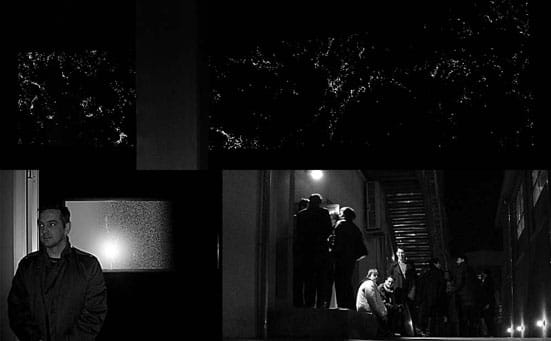Upon entering Pianissimo you turn right into a pitch black corridor,
feeling your way in the darkness. Edging around a corner you enter an
apparently endless space of immense blackness, in front of you floats a
universe of tiny pin-pricks of light, like distant stars. The scale is
distorted and disorientating, you could be looking out from the bridge
of a space ship or looking down from a vertiginous height or seeing
something powerfully magnified. The random patterns of light seem to
form themselves into continents or solar systems. You hear the slow
rumble of deep space, the sound of blood pumping around your body. It
is Sir Bernard Lovell's 1967 lecture 'Our Present Knowledge of the
Universe' slowed down to an unrecognisable 3 rpm. After ten minutes or
so your eyes start to adjust and the pillars of the room slowly begin
to emerge.
The title of the show plays on the word 'sidereal', used in astronomy
to denote that which is beyond our solar system. In his practice,
Collier's primary subject matter is man's striving towards an
understanding of the cosmos. Boundaries recur in his work, those that
divide the universe, the surface of the self, the internal imagination
and external universe, the bright light of certainty and the dark
curtain of doubt. In Istanbul last month, Collier tattooed a dot on his
skin to represent a kind of opposite, a final and logical equivalent,
to the furthest star visible with the naked eye, and projected it into
the night sky.
As Richard Panek examines in his book Seeing and Believing, the
astronomer's quest to develop ever more powerful telescopes has had a
profound effect on our conception of the cosmos; its size and our
position within it. From the time of Galileo our knowledge has
continuously expanded, from conceiving of the earth as fixed at the
centre of creation to the understanding that we are not the only
galaxy, but one of billions. Telescopes today can see tens of trillions
of miles into space and penetrate into time past. From the ancient
literary and religious trope of one's fate hanging in the stars, to the
science-fiction fantasies of today, the cosmos has always played a
central role in our cultural understanding of what it means to be
human.
Milan is a fairly ugly city by Italian standards but if you
escape the endless designer boutiques there are some lovely bars and
restaurants along the old canal in the Zona Naviglio. The Gothic
cathedral, the Duomo, is truly spectacular, its endless interior bathed
in eerie green light. Apparently most Milanese live outside the city
and commute in, then escape to the nearby mountains and lakes at the
weekend. The cutting edge galleries are gathered in a compound of
industrial-chic on Via Ventura, in the quiet suburb of Lambrate. Apart
from Pianissimo, there are about five other galleries in the complex,
including Galleria Massimo de Carlo currently showing Piotr Uklanski.
Another neighbour is Prometeogallery, at present showing Alexey
Buldakov, Peter Bystrov & Valery Chtak in 'Ars Erotica, Ars
Theoretica, Ars Politica', an examination of the post-soviet condition,
the highlight of which is an animation of a jiggling Constructivist
painting with a soundtrack of pornographic noises.
AM

Tobias Collier IN SIDEREAL at Pianissimo, Milan. The private view 17 January 2008: the installation, the artist in front of his work, the crowd outside the gallery.
Photography: T. Collier, A.MacGilp, A, Lee